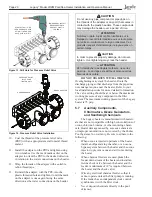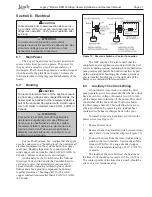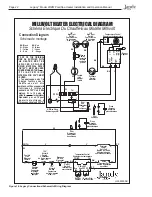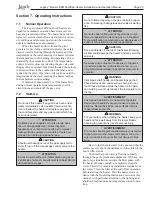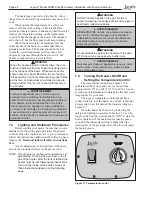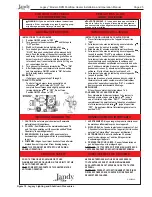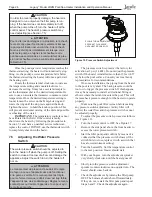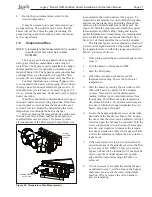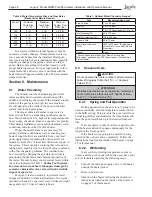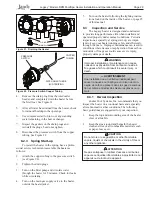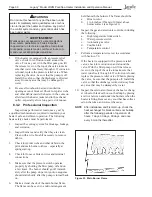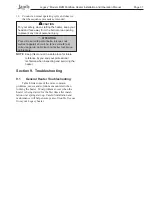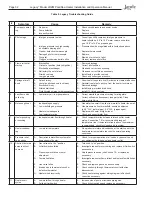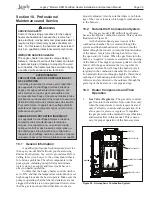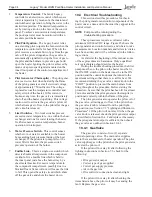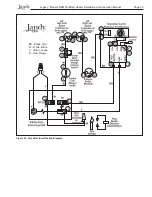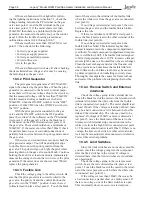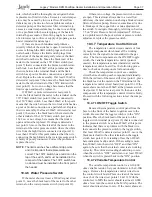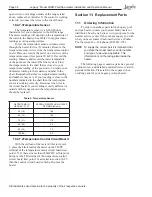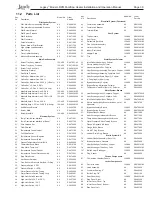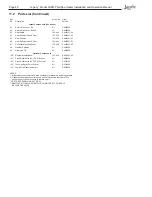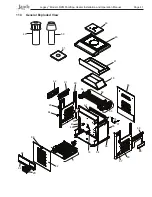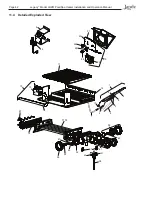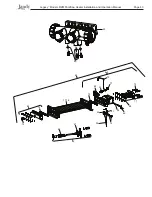
Page 34
Legacy
™
Model LRZM Pool/Spa Heater Installation and Operation Manual
2.
Temperature Control
- The Jandy Legacy
controller is an electronic control which senses
water temperature by means of a thermistor and
controls heater operation to bring the water to the
desired temperature. The desired temperature is
set by rotating a knob on the face of the control
panel. To achieve accurate water temperatures,
the pool/spa water must be monitored with an
accurate pool thermometer.
3.
Pilot/Pilot Ignition
- The Legacy heater relies
on a standing pilot to ignite the burners when the
temperature control calls for heat. When lit the
pilot receives a constant
fl
ow of gas from the gas
valve. If the pilot extinguishes, the gas valve is
automatically signalled to stop the
fl
ow of gas to
the pilot and the burners to prevent a gas build
up in the heater. Igniting the pilot is achieved by
means of a piezo spark igniter mounted on the
inner front panel of the controls compartment of
the heater.
4.
Pilot Generator (Thermopile) -
The pilot gener-
ator is a device, that when heated by the
fl
ame
of the pilot, generates a small electrical voltage
of approximately 750 millivolts. The voltage
is placed across the temperature controller and
safety circuit of the heater. If this current is
broken at any time, the gas valve is immediately
shut off and the heater stops
fi
ring. This voltage
is also used to activate the gas valve's pilot coil
which allows gas to
fl
ow to the pilot after the gas
valve knob is released.
5.
Limit Switches
- Two limit switches prevent
excessive water temperature - one within the heat
exchanger and one for water leaving the heater.
If either senses excessive temperature, burner
operation is interrupted.
6.
Water Pressure Switch
- This control senses
whether or not water is available to the heater
by measuring back pressure inside of the heat
exchanger. If the pool water pump fails or the
water
fi
lter is blocked, the pressure switch
prevents operation of the burner.
7.
Fusible Link
- This is a single-use switch which
detects abnormal temperature in the component
vestibule. It is a fusible link which is held to
the inner panel just above the burner tray by a
sheet metal bracket. Excessive temperature in
the component compartment, possibly due to a
blocked
fl
ue or
fl
ame roll-out, will cause the link
to fail. This opens the safety circuit which shuts
off the gas valve and shuts the heater down.
10.4 Electrical
Troubleshooting
This section describes procedures for check-
ing the pilot generator and control components of the
heater one at a time and in the order they appear in the
control circuit.
NOTE
Pump must be running during the
troubleshooting procedure.
These procedures require a voltmeter with a
minimum 0-1000 mVDC range. Figure 25 shows the
pilot generator and control circuits, and where to take
measurements. Location numbers and letters in circles
have been added, and will be referenced in the follow-
ing sections.
As stated at the beginning of this manual, some
of these procedures are hazardous. Only a quali
fi
ed
service technician should service the heater.
During the trouble shooting procedure, the
fi
lter
pump must be on, the pilot on the heater must be lit,
the ON/OFF switch on the heater must be in the ON
position and the control knob must be turned to the
maximum setting so that there is a call for heat. We
recommend turning the gas valve control knob to the
"PILOT" position to prevent the main burners from
fi
ring throughout the procedure. Before starting the
procedure, be sure that the pilot has been lit for at least
2 minutes and that the pilot generator (thermopile) is
positioned correctly within the
fl
ame of the pilot.
The pilot generator also operates the pilot coil of
the gas valve, allowing gas to
fl
ow to the pilot when
the gas valve knob is released from the pilot light-
ing position (see Section 7.3 "Lighting and Shutdown
Procedures"). If the pilot will not stay lit when the gas
valve knob is released, check the pilot generator output
as described in Section 10.4.2 and replace if necessary.
If the pilot generator output is suf
fi
cient, then check
the gas valve as outlined in Section 10.4.1.
10.4.1 Gas Valve
The gas valve consists of two (2) separate
internal operating valves. The main valve supplies
gas to the main burners for heater operation. The pilot
valve supplies gas to the pilot when the pilot generator
activates the pilot coil.
If the pilot will not stay lit after following the
lighting instructions in Section 7.3, check for the
following:
• Pilot generator output
• Correct type of gas supplied
• Correct gas supply pressure
• Air in the gas line
• Pilot coil wire connections clean and tight
If the pilot will not stay lit after checking the
items listed above, the pilot coil may be causing the
fault. Replace the gas valve.
Summary of Contents for Legacy LRZM
Page 2: ......

